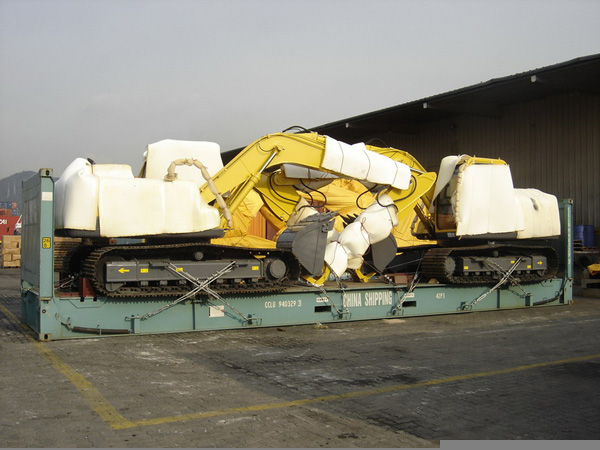
OOG transportation case
Cargo status: Shekou-Jebel ali 4 engineering excavators 2*40FR
The operation of special shipping containers is difficult and complex. The entire special container transportation process requires confirmation of multiple links before it can be transported.
After rigorous confirmation, our company signed an agreement with the customer, and finally selected COSCO China Ocean Shipping Company as the carrier from multiple shipping companies, which reasonably and economically solved the transportation difficulties of over-width and over-height equipment (both width and height reached Limit value 5M), the problem of transporting heavy-weight large equipment has been eliminated, and more than 10 difficult issues such as the determination of the center of gravity and the selection of lashing points during the loading process of goods have been eliminated, and the goods have finally been shipped safely and on time.

Machine tool equipment, electrical equipment, loaders, excavator dump trucks, tractors and other types of goods that cannot be packed in boxes should be packed in flatbed containers because the goods are over long and over wide. Everything from sea freight to flatbed installation to reinforcement is relatively expensive, so we have to apply to the shipping company for the price. Since container shipping covers many routes and the shipping schedule is relatively punctual, there are ships every week. Cargo owners hope to use container ships to meet multiple needs for their cargo. Small quantities of goods generally choose container ships. When the customer accepts the price and shipping date. The cargo owner issues a booking entrustment to establish a cooperative relationship.

There are two ways to pack and collect goods at the port. The first is to install flat-panel special containers at the place of origin. That is, the shipping company picks up the boxes and then uses a truck to pull the cabinets to the manufacturer for loading. After completion, the goods are collected at the port, shipped, and cleared for customs. Second, the shipper will be given the corresponding cargo collection port notification 7-10 days before the ship is berthed after packing at the port yard. Indicate: loading/unloading port, ship name, voyage number, bill of lading number, collection time/address, port contact person, etc. Send the goods into the port area, and the on-site contact person will arrange loading, shipping, etc. The goods must be declared to customs before being shipped (necessary for customs clearance: cargo box list, invoice, trade contract, customs declaration power of attorney, customs declaration form); prepare the materials and deliver them to the customs broker. After customs clearance is completed, the goods will be eligible for export. After the ship berths, it is arranged for loading. The goods are hoisted onto the ship through a shore crane. They are hoisted onto the ship and placed on the topmost level of the container at the designated cabin capacity. They are fixed and tied, padded and reinforced with wire rope containers to prevent Rolling or deformation occurs.

After completing the shipment, confirming the cost and bill of lading, the ship's voyage was also tracked via GPRS. The finance department receives the shipowner's ocean freight invoice and the ground company's port miscellaneous fee invoice, and issues an invoice to the customer. After the customer's payment is completed, we pay the fees to the shipowner and the ground company, and the shipowner releases the original bill of lading. Complete shipping transactions.
 English
English 简体中文
简体中文 हिन्दी
हिन्दी Español
Español العربية
العربية বাংলা
বাংলা Français
Français Русский
Русский Português
Português اردو
اردو فارسی
فارسی Türkçe
Türkçe كوردی
كوردی Deutsch
Deutsch 日本語
日本語 ไทย
ไทย Tiếng Việt
Tiếng Việt Italiano
Italiano






